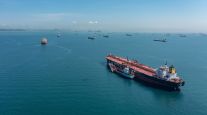Return of Seasonal Shipping Peak Brightens Fleets’ Holiday Outlook
This story appears in the Oct. 18 print edition of Transport Topics.
Truckers and other carriers are reporting a seasonal pickup in freight volumes this fall that is in sharp contrast to 2009, when the recession ravaged cargo volumes, experts said.
The 2010 holiday shipping season “will be substantially better than last year, but not at 2006 or 2007 levels,” Max Fuller, co-chairman of U.S. Xpress Enterprises Inc., Chattanooga, Tenn., told Transport Topics.
Meanwhile, other indicators such as rail intermodal freight shipments also are fueling a stronger outlook as those volumes approach or match pre-recession levels.
In another sign of strength, Wal-Mart Stores Inc., the biggest U.S. retailer, said the fourth quarter would produce the first quarter-over-quarter increase in sales since mid-2009 at stores open more than one year, Bloomberg News reported Oct. 13.
“Retailers have told us there is going to be more product moving later in the season — in October, November and early December,” Fuller said.
Last year, the truckload carrier’s volume dropped in October, compared with September, contradicting the usual pattern of volume growth that begins in August and builds until early November.
Part of the reason for the change, he said, is that retailers are keeping more products on store shelves instead of warehouses as supply chains become more efficient.
“[Retailers] are bringing products directly to the store and they have no real backup inventory,” said Fuller, who noted that will help truckers.
“That levels out the business for us,” Fuller said. “If they fill the shelves instead of warehouses, there is a constant flow of business and that is good for trucking.”
On the rail side, September intermodal volume rose 17% from 2009 levels.
“September was a steady month for rail traffic, with new weekly records set in both carloads and intermodal,” John Gray, senior vice president of the Association of American Railroads, said in an Oct. 7 statement. “Intermodal traffic gains can be attributed to the upcoming holiday season.”
Some analysts said they also detected peaking volumes.
“We are seeing the first fall peak in several years,” said Avondale Partners analyst Donald Broughton. “Anecdotally, carriers are telling me they are seeing very good volume.”
As evidence, he cited the freight index by Cass Information Systems, a St. Louis freight payment firm, which showed shipments rose 2% from August to September.
The shipments index is at its highest level in two years, having reached 12% higher than September of last year and less than 1% above that month of 2008.
The index includes all modes of transport, but is primarily from trucking moves and is based on $17 billion of annual bills paid.
“We are still going to a see a decent peak,” said Jeff Kauffman, an analyst at Sterne Agee. “It will be more of a smooth one and not the traditional Pikes Peak from past years.”
Kauffman said this year’s peak began early because of concerns about a recurrence of the vessel capacity shortage in 2009.
“This year, everyone was prepared for that, but there was a shortage of empty boxes earlier this year,” he said.
Ocean carriers alleviated that problem by unloading their containers in port areas instead of letting the boxes move inland, freeing up more containers that could be sent back to Asia for another load, Kauffman said.
On the other hand, some indicators weren’t as upbeat.
The Pulse of Commerce index, which is based on diesel fuel purchases, showed a slowdown in growth as the index rose 5.8% from September of last year, but the pace was far below the 9% recorded in May and the index declined on a month-to-month basis.
“Freight volumes for the remainder of the year are likely to be lackluster, as the freight peak was pulled forward this year,” Stifel Nicolaus analyst John Larkin said in an Oct. 7 report.
The National Retail Federation, a trade group, said August will be the biggest month for international shipments this year, instead of the traditional October peak.
The trade group, in conjunction with the consulting firm Hackett Associates, based its projections on a monthly report called Port Tracker that analyzes freight volumes at the 10 largest U.S. ports, including those in southern California and the New York area.
That report found 1.42 million 20-foot units were handled in August at those ports, 23% above that month of last year.
September totals are expected to be 1.37 million units, followed by 1.32 million units in October, the report said.
“Cargo is still coming through, but retailers are mostly stocked up for the holiday season,” said Jonathan Gold, NRF’s vice president for supply chain and customs policy.




